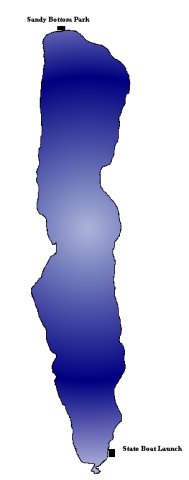-
-
-
-
-
-
Honeoye Lake Guide
-
-
-
 Welcome to the Honeoye Valley Association |
The 2015 Homeowner's Guide to Lake Friendly Living is available here ----> Lake guide 2015 pdf
Honeoye Lake Guide
Tenth in size among the eleven Finger Lakes, Honeoye Lake is located 28 miles south of Rochester in southwestern Ontario county.
PHYSICAL FEATURES
Elevation: 804 feet
Area: 1,772 acres
Length: 4.5 miles
Maximum Width: 0.8 miles
Maximum Depth: 30 feet
WATER QUALITY:
The principal use of Honeoye Lake is for water-based recreation. While Honeoye’s deepest waters are not completely oxygen-saturated during summer due to decomposition of abundant plant materials, oxygen levels are sufficient for fish life. At times water clarity is impaired by algae blooms.
PLANT LIFE:
Rooted aquatic vegetation is common to abundant in nearshore areas of the lake, and out to a depth of about 15 feet. Eelgrass, pondweed, Eurasian milfoil and water stargrass are the predominant plant species.
FISH MANAGEMENT:
Modern fisheries management at Honeoye Lake began with the placement of seasons, bag limits and size limits on gamefish. Records indicate that Honeoye was first stocked with walleye around the turn of the century. Today, the co-dominant sport species are walleye, largemouth bass, smallmouth bass and chain pickerel, with walleye the only species stocked (8.7 million fry annually) into the lake by the DEC.
Honeoye is a highly regarded fishing lake. In addition to its excellent sportfish opportunities, the lake also supports an outstanding panfish fishery for bluegill, pumpkinseed, yellow perch and black crappie.
Current management emphasis for Honeoye Lake is to maintain a relatively high density of predator species to control the abundant panfish. Periodic fishery surveys are conducted to monitor fish populations.
An ongoing angler diary cooperator program for sportfish provides DEC fisheries staff with useful data on population trends. If you are interested in signing up as a cooperator, please contact the DEC Region 8 Office.

FISHING TIPS:
Walleyeundefined Fishing is most productive at low light intensityundefinedearly morning, evening and at night. Drift or troll slowly with spinner and worm harness combinations, or with stickbaits (Rebels, Rapalas, etc.). Drifting or casting jigs tipped with worms, leeches or minnows also works well. In spring, fish shallows, particularly near the inlet. Later in the season concentrate your efforts in deeper waters with weedbeds. In winter, use tip-ups and minnows or jigs with minnow imitations. Winter anglers should also give night fishing a try, but only when safe ice conditions prevail.
Chain PickerelundefinedCast spoons, spinners, spinnerbaits, stickbaits, and rubber worms in and near weedbeds. Large shiners suspended under bobbers also work well. The south end of the lake is good, but any weedbed should hold pickerel. Ice fish with tip-ups and minnows.
Largemouth Bassundefined Fish shallow weedy areas and use plastic worms, spinnerbaits, jigs-n-pigs, weedless crankbaits and surface plugs. Early in the season concentrate your efforts in water 6 feet deep or less. As the season progresses try weedbeds in 10 to15 feet of water.
Smallmouth Bassundefined Fish near gravel areas in the early morning and late afternoon. In the spring and fall fish in depths to 15 feet; fish deeper in summer. Pay particular attention to gravel areas where streams enter the lake after rainstorms. Stillfish with crayfish, minnows, leeches and worms, or cast spinnerbaits, crankbaits and spoons. Plastic worms, jigs, spinners and surface baits also work well.
Bluegills and Sunfishundefined Look for weedy areas and you will find sunfish. Anchor and fish, or ice fish with jigs tipped with grubs or worms. Use one or two pound test line for best results.
Yellow PerchundefinedLook for perch in shallow weedy bays and near shoals. Anchor and fish, or ice fish with jigs tipped with grubs, worms, wigglers or minnows. Perch may be in deep water in winter